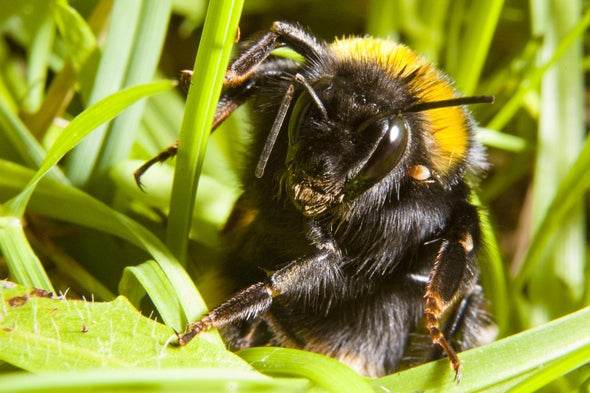(单词翻译:单击)
听力文本
This is Scientific American's 60-second Science, I'm Christopher Intagliata.
They're furry, fat and hibernate all winter. Not bears — bumblebees. Specifically the queens, which emerge from hibernation in the spring to establish new colonies — a bit of a trek away.
"We knew that queens end up kilometers from the previous year's natal nest site but we didn't know anything about how they get there." Clint Perry, a cognitive biologist at Queen Mary University of London.
To observe that phenomenon in action, he and his team glued antennas to the backs of 20 bumblebee queens, which had been kept under simulated hibernation conditions. The researchers then tracked the insects with radar as they emerged from small dens in the dirt and found that bumblebees take wing for only 10 to 20 seconds before landing for much longer layovers.
"We were all surprised the bees spent so much time resting in the ground and that they seem to sleep for so much time even. I personally found it amusing and cute that they position their bodies so their head was under a leaf or under grass while their butt was still sticking out in the open."

Observations of wild bees confirmed they do this too — and that it wasn't just the transponders affecting the bees' behavior. As for how they wind up kilometers away from the previous year's nest site? Computer modeling suggests even these short random bursts of flight would do the job. The results are in the journal Scientific Reports.
The findings suggest some queen-friendly conservation ideas too: "It would likely help queen bumblebee survival if we established pollinator-friendly corridors between conserved landscape patches. That means planting more pollinator-friendly flowers and pollinator-friendly trees and flowers year-round."
The queens also take shelter in long grass and leaf litter, suggesting an intervention closer to home — if you can resist raking, that is.
Thanks for listening for Scientific American — 60-Second Science. I'm Christopher Intagliata.
参考译文
这里是科学美国人——60秒科学系列,我是克里斯托弗·因塔格里塔。
它们毛茸茸、胖胖的,整个冬天都在冬眠。我们说的不是熊,而是大黄蜂。尤其是蜂王,它们在春天从冬眠中苏醒过来,建立新蜂群——在稍微跋涉一段距离之后。
“我们知道蜂王会在距离前一年自己出生的巢穴数公里远的地方筑巢,但我们对它们是如何到达那里的一无所知。”伦敦玛丽女王大学的认知生物学家克林特·佩里说到。
为了观察这一现象,他和他的团队将天线粘在20只大黄蜂蜂王的背上,这些蜂王一直处于模拟冬眠状态。随后,研究人员用雷达追踪这些蜂王从泥土中的小巢里钻出来的情况,他们发现,蜂王只飞行10到20秒,之后便长时间落地停歇。
“我们都非常惊讶,蜂王竟然会花这么多时间在地上休息,它们似乎甚至还睡了很长时间。我个人认为有趣又可爱的是,它们将自已的身体藏在叶子或草下面,而它们的屁股却露在外面。”
经过观察,他们证实野蜂也会这样做——说明并不是应答器影响了蜜蜂的行为。那蜂王是如何离开前一年的巢穴到数英里之外去的?计算机模型显示,即使是这种简短、随意地爆发式飞行也能做到这一点。研究结果发表在《科学报告》期刊上。
研究结果提出了一些有利于蜂王生存的保护理念:“如果我们在保护景观斑块之间建立‘授粉友好型’通道,这可能会有助于蜂王的生存。也就是说,要全年种植更多有利于授粉的花和树。”
蜂王还会躲在长草和落叶中,这意味着家附近也能进行干预——如果你能忍住不去清理的话。
谢谢大家收听科学美国人——60秒科学。我是克里斯托弗·因塔利亚塔。
译文为可可英语翻译,未经授权请勿转载!
重点讲解
重点讲解:
1. emerge from 出现;露出;
The swimmer emerged from the lake.
游泳者从湖水中浮出来。
2. end up (通常指意外地)最终到达;
The result was that the engine ended up at the bottom of the canal.
结果引擎最终沉到了运河底。
3. stick out 伸出;探出;
She made a face and stuck out her tongue at him.
她做了个鬼脸,向他吐了吐舌头。
4. wind up (以…)告终;
Little did I know that I would actually wind up being on the staff.
我完全没有想到自己最后竟会在这里供职。


